BFA728 Finance for Managers Assignment: Capital Budgeting and Equity
VerifiedAdded on 2022/10/17
|12
|2136
|63
Homework Assignment
AI Summary
This assignment analyzes capital budgeting techniques, including payback period, net present value (NPV), and internal rate of return (IRR), to evaluate the suitability of printer investments. The analysis compares two printers, identifying conflicting rankings based on different methods and exploring the theoretical and practical bases for decision-making. Furthermore, the assignment delves into private equity investments, discussing their global resurgence, various types (leveraged buyout, growth equity, and venture capital funds), and associated opportunities and risks such as operational, funding, and liquidity risks. The report concludes with a summary of the findings, emphasizing the role of private equity as a funding instrument and the importance of understanding both the advantages and potential risks for business managers.

Running head: FINANCE FOR MANAGER
Finance for manager
Name of the Student
Name of the University
Author’s note
Finance for manager
Name of the Student
Name of the University
Author’s note
Paraphrase This Document
Need a fresh take? Get an instant paraphrase of this document with our AI Paraphraser
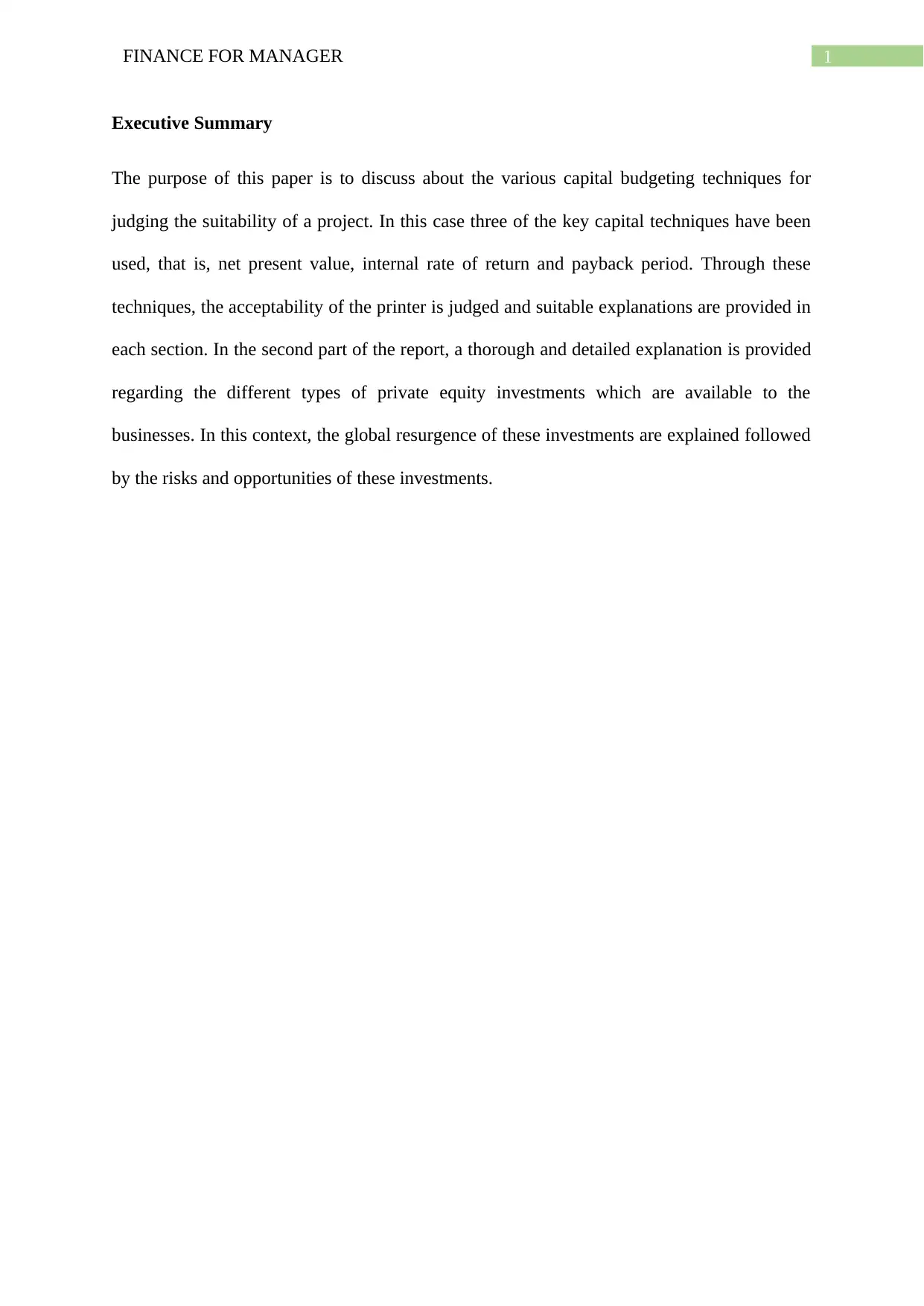
1FINANCE FOR MANAGER
Executive Summary
The purpose of this paper is to discuss about the various capital budgeting techniques for
judging the suitability of a project. In this case three of the key capital techniques have been
used, that is, net present value, internal rate of return and payback period. Through these
techniques, the acceptability of the printer is judged and suitable explanations are provided in
each section. In the second part of the report, a thorough and detailed explanation is provided
regarding the different types of private equity investments which are available to the
businesses. In this context, the global resurgence of these investments are explained followed
by the risks and opportunities of these investments.
Executive Summary
The purpose of this paper is to discuss about the various capital budgeting techniques for
judging the suitability of a project. In this case three of the key capital techniques have been
used, that is, net present value, internal rate of return and payback period. Through these
techniques, the acceptability of the printer is judged and suitable explanations are provided in
each section. In the second part of the report, a thorough and detailed explanation is provided
regarding the different types of private equity investments which are available to the
businesses. In this context, the global resurgence of these investments are explained followed
by the risks and opportunities of these investments.
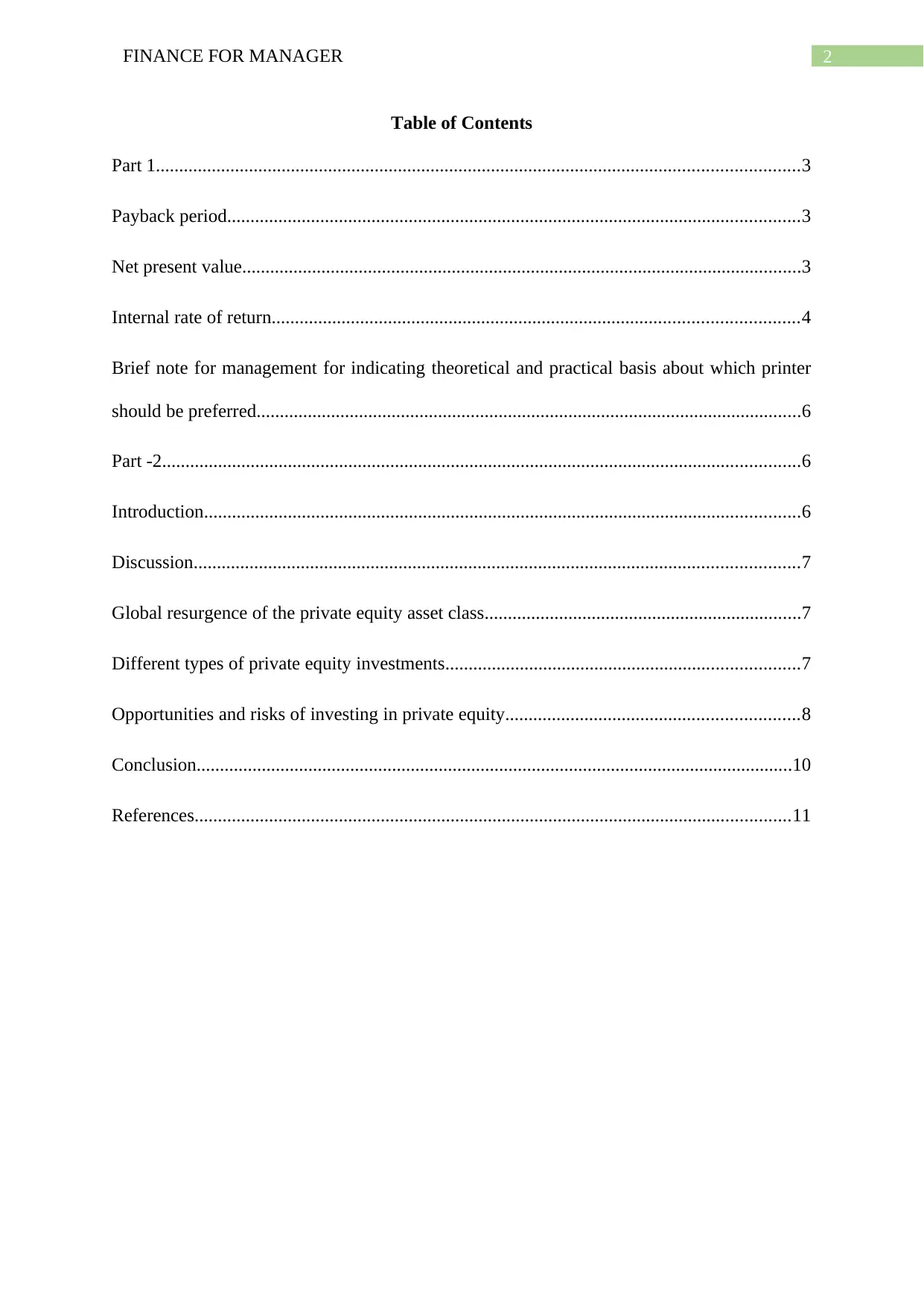
2FINANCE FOR MANAGER
Table of Contents
Part 1..........................................................................................................................................3
Payback period...........................................................................................................................3
Net present value........................................................................................................................3
Internal rate of return.................................................................................................................4
Brief note for management for indicating theoretical and practical basis about which printer
should be preferred.....................................................................................................................6
Part -2.........................................................................................................................................6
Introduction................................................................................................................................6
Discussion..................................................................................................................................7
Global resurgence of the private equity asset class....................................................................7
Different types of private equity investments............................................................................7
Opportunities and risks of investing in private equity...............................................................8
Conclusion................................................................................................................................10
References................................................................................................................................11
Table of Contents
Part 1..........................................................................................................................................3
Payback period...........................................................................................................................3
Net present value........................................................................................................................3
Internal rate of return.................................................................................................................4
Brief note for management for indicating theoretical and practical basis about which printer
should be preferred.....................................................................................................................6
Part -2.........................................................................................................................................6
Introduction................................................................................................................................6
Discussion..................................................................................................................................7
Global resurgence of the private equity asset class....................................................................7
Different types of private equity investments............................................................................7
Opportunities and risks of investing in private equity...............................................................8
Conclusion................................................................................................................................10
References................................................................................................................................11
⊘ This is a preview!⊘
Do you want full access?
Subscribe today to unlock all pages.

Trusted by 1+ million students worldwide
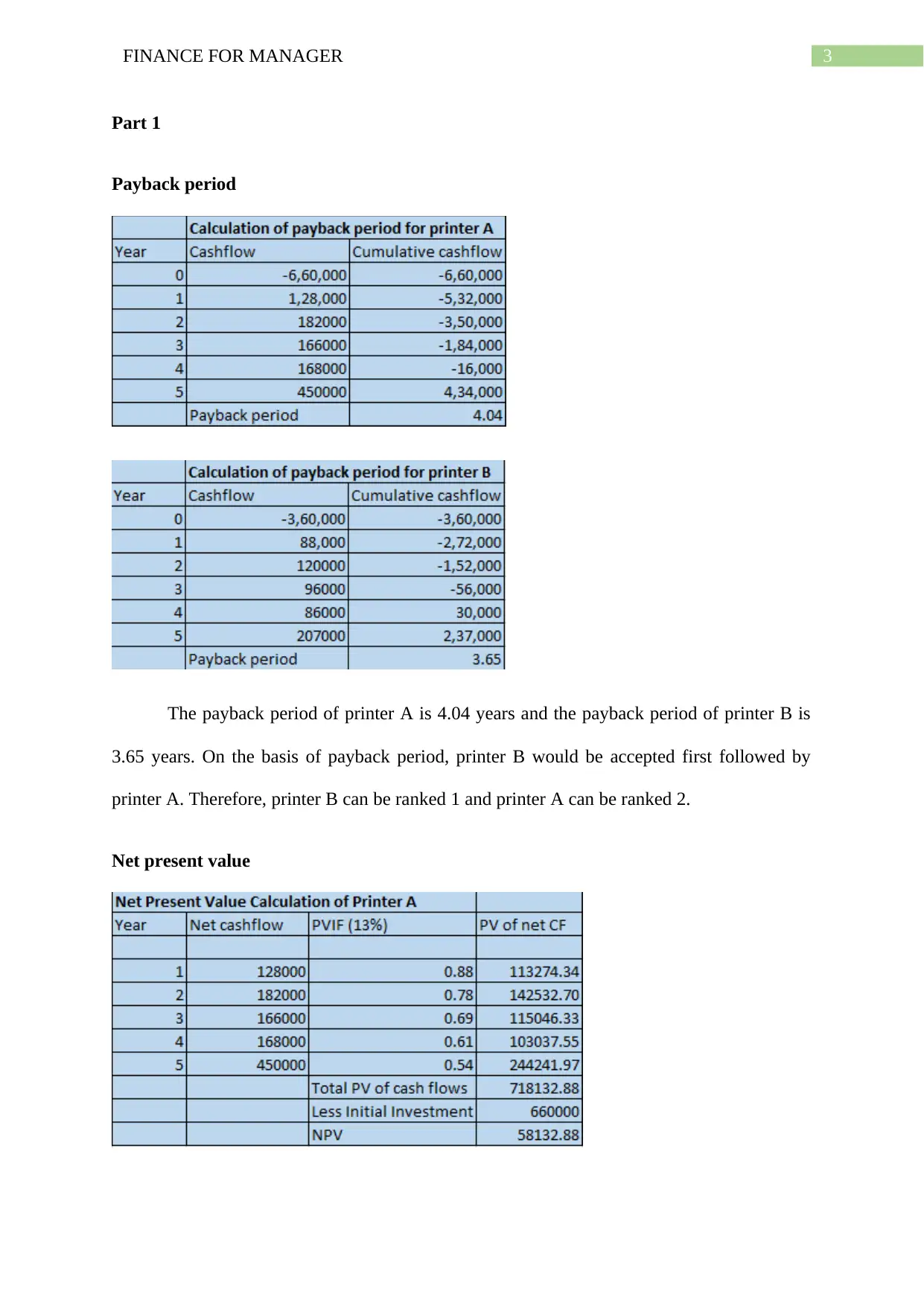
3FINANCE FOR MANAGER
Part 1
Payback period
The payback period of printer A is 4.04 years and the payback period of printer B is
3.65 years. On the basis of payback period, printer B would be accepted first followed by
printer A. Therefore, printer B can be ranked 1 and printer A can be ranked 2.
Net present value
Part 1
Payback period
The payback period of printer A is 4.04 years and the payback period of printer B is
3.65 years. On the basis of payback period, printer B would be accepted first followed by
printer A. Therefore, printer B can be ranked 1 and printer A can be ranked 2.
Net present value
Paraphrase This Document
Need a fresh take? Get an instant paraphrase of this document with our AI Paraphraser
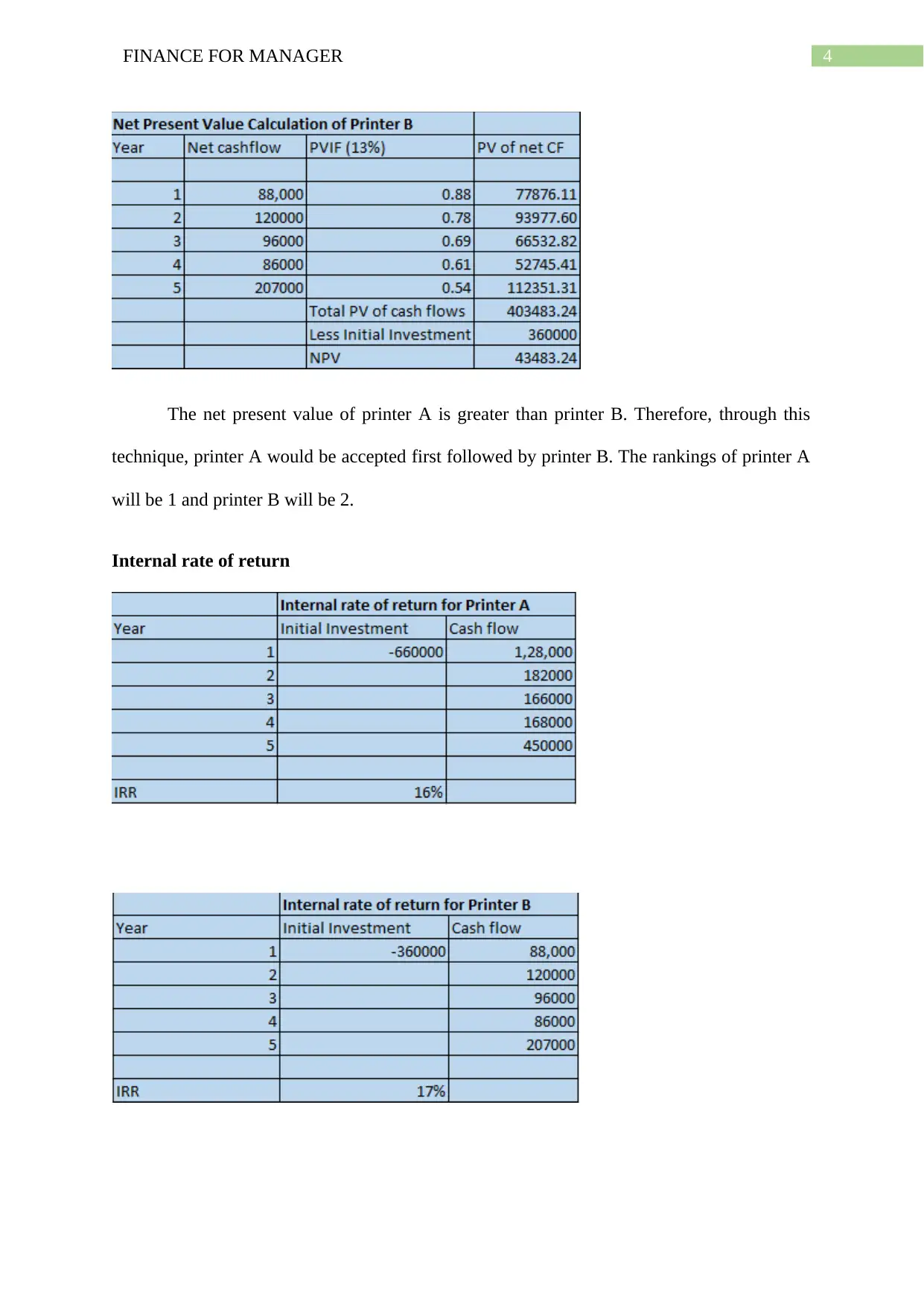
4FINANCE FOR MANAGER
The net present value of printer A is greater than printer B. Therefore, through this
technique, printer A would be accepted first followed by printer B. The rankings of printer A
will be 1 and printer B will be 2.
Internal rate of return
The net present value of printer A is greater than printer B. Therefore, through this
technique, printer A would be accepted first followed by printer B. The rankings of printer A
will be 1 and printer B will be 2.
Internal rate of return
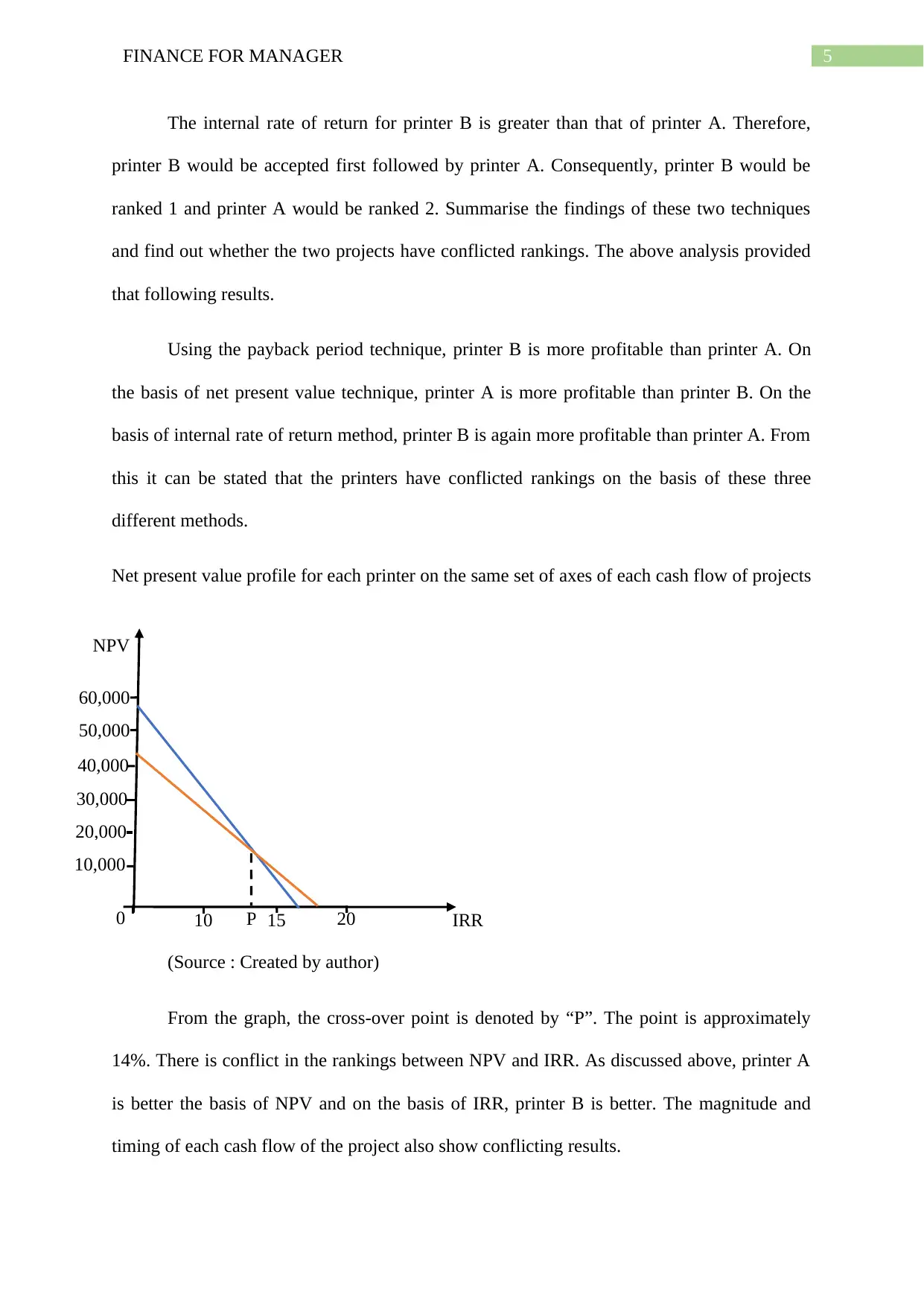
5FINANCE FOR MANAGER
The internal rate of return for printer B is greater than that of printer A. Therefore,
printer B would be accepted first followed by printer A. Consequently, printer B would be
ranked 1 and printer A would be ranked 2. Summarise the findings of these two techniques
and find out whether the two projects have conflicted rankings. The above analysis provided
that following results.
Using the payback period technique, printer B is more profitable than printer A. On
the basis of net present value technique, printer A is more profitable than printer B. On the
basis of internal rate of return method, printer B is again more profitable than printer A. From
this it can be stated that the printers have conflicted rankings on the basis of these three
different methods.
Net present value profile for each printer on the same set of axes of each cash flow of projects
(Source : Created by author)
From the graph, the cross-over point is denoted by “P”. The point is approximately
14%. There is conflict in the rankings between NPV and IRR. As discussed above, printer A
is better the basis of NPV and on the basis of IRR, printer B is better. The magnitude and
timing of each cash flow of the project also show conflicting results.
NPV
IRR0 P 202020
20
1510
10,000
0
20,000
30,000
40,000
50,000
60,000
The internal rate of return for printer B is greater than that of printer A. Therefore,
printer B would be accepted first followed by printer A. Consequently, printer B would be
ranked 1 and printer A would be ranked 2. Summarise the findings of these two techniques
and find out whether the two projects have conflicted rankings. The above analysis provided
that following results.
Using the payback period technique, printer B is more profitable than printer A. On
the basis of net present value technique, printer A is more profitable than printer B. On the
basis of internal rate of return method, printer B is again more profitable than printer A. From
this it can be stated that the printers have conflicted rankings on the basis of these three
different methods.
Net present value profile for each printer on the same set of axes of each cash flow of projects
(Source : Created by author)
From the graph, the cross-over point is denoted by “P”. The point is approximately
14%. There is conflict in the rankings between NPV and IRR. As discussed above, printer A
is better the basis of NPV and on the basis of IRR, printer B is better. The magnitude and
timing of each cash flow of the project also show conflicting results.
NPV
IRR0 P 202020
20
1510
10,000
0
20,000
30,000
40,000
50,000
60,000
⊘ This is a preview!⊘
Do you want full access?
Subscribe today to unlock all pages.

Trusted by 1+ million students worldwide
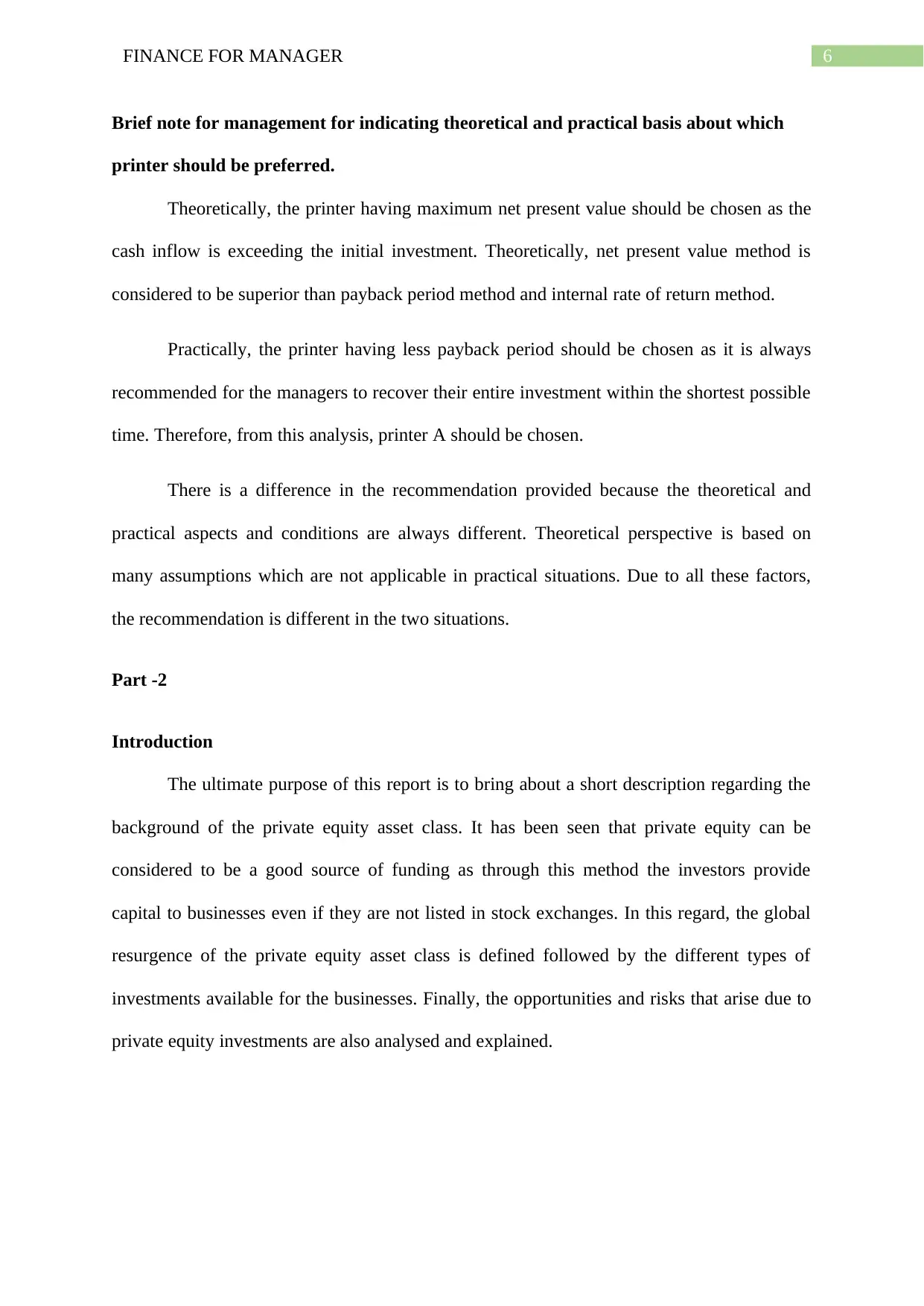
6FINANCE FOR MANAGER
Brief note for management for indicating theoretical and practical basis about which
printer should be preferred.
Theoretically, the printer having maximum net present value should be chosen as the
cash inflow is exceeding the initial investment. Theoretically, net present value method is
considered to be superior than payback period method and internal rate of return method.
Practically, the printer having less payback period should be chosen as it is always
recommended for the managers to recover their entire investment within the shortest possible
time. Therefore, from this analysis, printer A should be chosen.
There is a difference in the recommendation provided because the theoretical and
practical aspects and conditions are always different. Theoretical perspective is based on
many assumptions which are not applicable in practical situations. Due to all these factors,
the recommendation is different in the two situations.
Part -2
Introduction
The ultimate purpose of this report is to bring about a short description regarding the
background of the private equity asset class. It has been seen that private equity can be
considered to be a good source of funding as through this method the investors provide
capital to businesses even if they are not listed in stock exchanges. In this regard, the global
resurgence of the private equity asset class is defined followed by the different types of
investments available for the businesses. Finally, the opportunities and risks that arise due to
private equity investments are also analysed and explained.
Brief note for management for indicating theoretical and practical basis about which
printer should be preferred.
Theoretically, the printer having maximum net present value should be chosen as the
cash inflow is exceeding the initial investment. Theoretically, net present value method is
considered to be superior than payback period method and internal rate of return method.
Practically, the printer having less payback period should be chosen as it is always
recommended for the managers to recover their entire investment within the shortest possible
time. Therefore, from this analysis, printer A should be chosen.
There is a difference in the recommendation provided because the theoretical and
practical aspects and conditions are always different. Theoretical perspective is based on
many assumptions which are not applicable in practical situations. Due to all these factors,
the recommendation is different in the two situations.
Part -2
Introduction
The ultimate purpose of this report is to bring about a short description regarding the
background of the private equity asset class. It has been seen that private equity can be
considered to be a good source of funding as through this method the investors provide
capital to businesses even if they are not listed in stock exchanges. In this regard, the global
resurgence of the private equity asset class is defined followed by the different types of
investments available for the businesses. Finally, the opportunities and risks that arise due to
private equity investments are also analysed and explained.
Paraphrase This Document
Need a fresh take? Get an instant paraphrase of this document with our AI Paraphraser
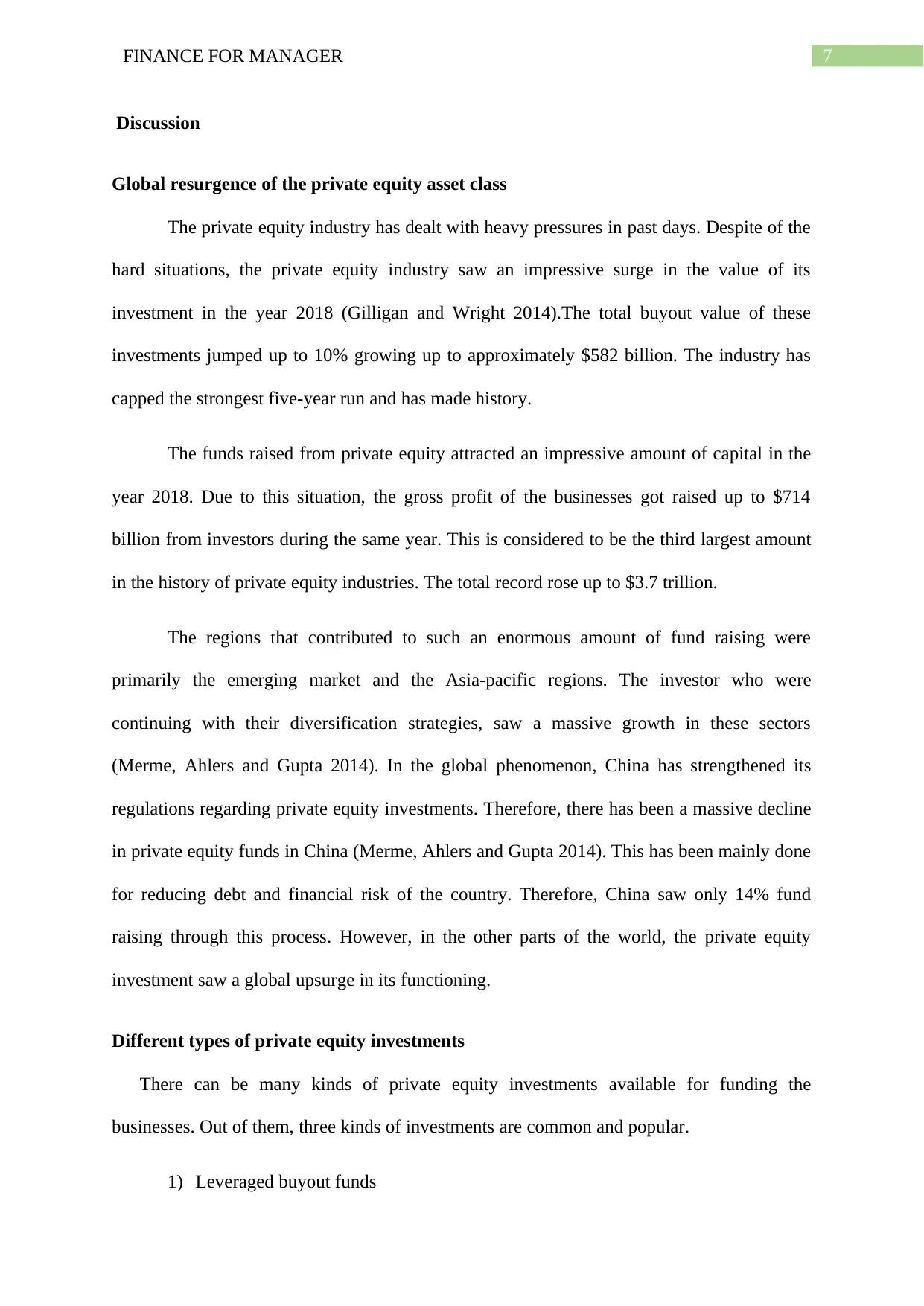
7FINANCE FOR MANAGER
Discussion
Global resurgence of the private equity asset class
The private equity industry has dealt with heavy pressures in past days. Despite of the
hard situations, the private equity industry saw an impressive surge in the value of its
investment in the year 2018 (Gilligan and Wright 2014).The total buyout value of these
investments jumped up to 10% growing up to approximately $582 billion. The industry has
capped the strongest five-year run and has made history.
The funds raised from private equity attracted an impressive amount of capital in the
year 2018. Due to this situation, the gross profit of the businesses got raised up to $714
billion from investors during the same year. This is considered to be the third largest amount
in the history of private equity industries. The total record rose up to $3.7 trillion.
The regions that contributed to such an enormous amount of fund raising were
primarily the emerging market and the Asia-pacific regions. The investor who were
continuing with their diversification strategies, saw a massive growth in these sectors
(Merme, Ahlers and Gupta 2014). In the global phenomenon, China has strengthened its
regulations regarding private equity investments. Therefore, there has been a massive decline
in private equity funds in China (Merme, Ahlers and Gupta 2014). This has been mainly done
for reducing debt and financial risk of the country. Therefore, China saw only 14% fund
raising through this process. However, in the other parts of the world, the private equity
investment saw a global upsurge in its functioning.
Different types of private equity investments
There can be many kinds of private equity investments available for funding the
businesses. Out of them, three kinds of investments are common and popular.
1) Leveraged buyout funds
Discussion
Global resurgence of the private equity asset class
The private equity industry has dealt with heavy pressures in past days. Despite of the
hard situations, the private equity industry saw an impressive surge in the value of its
investment in the year 2018 (Gilligan and Wright 2014).The total buyout value of these
investments jumped up to 10% growing up to approximately $582 billion. The industry has
capped the strongest five-year run and has made history.
The funds raised from private equity attracted an impressive amount of capital in the
year 2018. Due to this situation, the gross profit of the businesses got raised up to $714
billion from investors during the same year. This is considered to be the third largest amount
in the history of private equity industries. The total record rose up to $3.7 trillion.
The regions that contributed to such an enormous amount of fund raising were
primarily the emerging market and the Asia-pacific regions. The investor who were
continuing with their diversification strategies, saw a massive growth in these sectors
(Merme, Ahlers and Gupta 2014). In the global phenomenon, China has strengthened its
regulations regarding private equity investments. Therefore, there has been a massive decline
in private equity funds in China (Merme, Ahlers and Gupta 2014). This has been mainly done
for reducing debt and financial risk of the country. Therefore, China saw only 14% fund
raising through this process. However, in the other parts of the world, the private equity
investment saw a global upsurge in its functioning.
Different types of private equity investments
There can be many kinds of private equity investments available for funding the
businesses. Out of them, three kinds of investments are common and popular.
1) Leveraged buyout funds
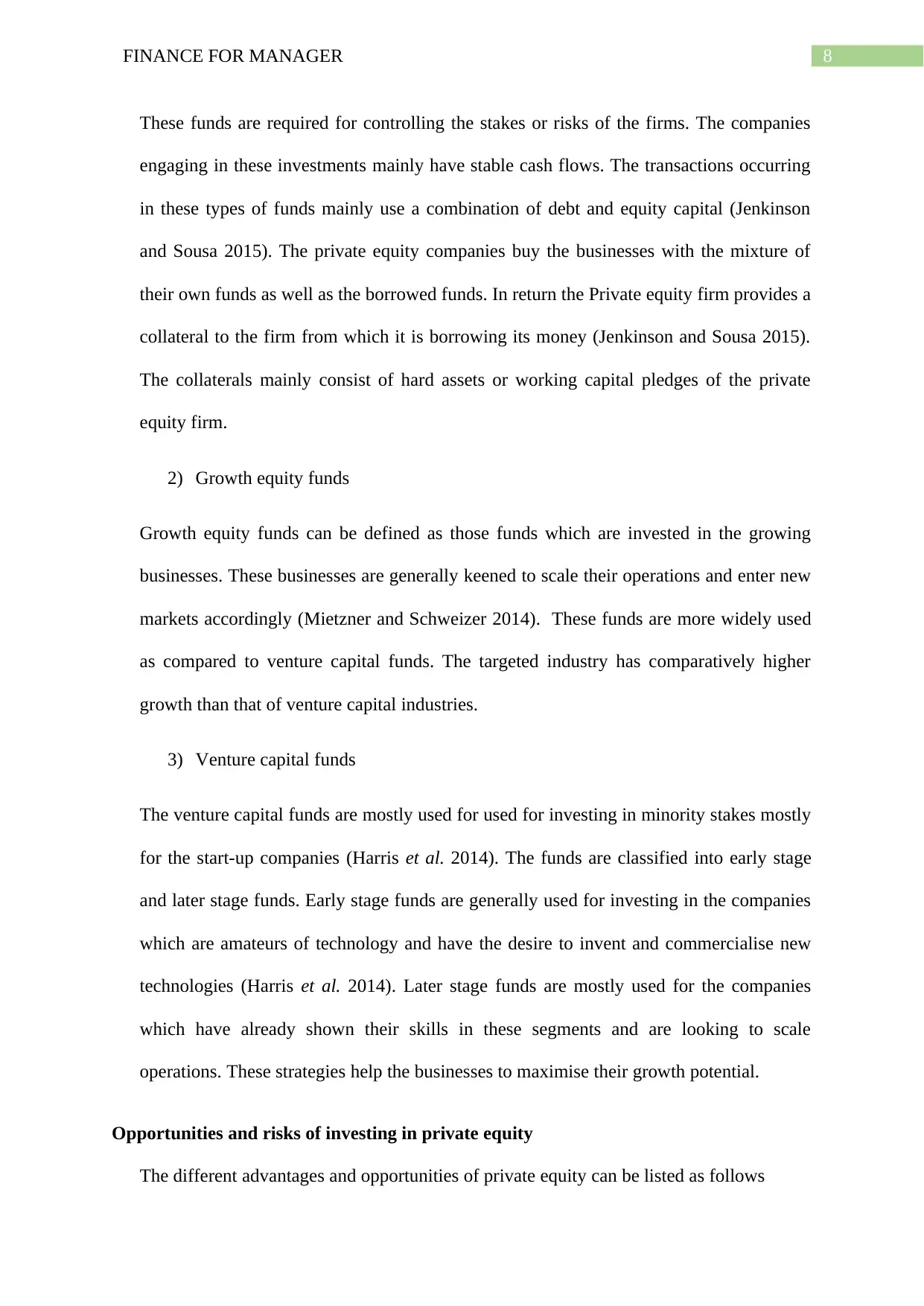
8FINANCE FOR MANAGER
These funds are required for controlling the stakes or risks of the firms. The companies
engaging in these investments mainly have stable cash flows. The transactions occurring
in these types of funds mainly use a combination of debt and equity capital (Jenkinson
and Sousa 2015). The private equity companies buy the businesses with the mixture of
their own funds as well as the borrowed funds. In return the Private equity firm provides a
collateral to the firm from which it is borrowing its money (Jenkinson and Sousa 2015).
The collaterals mainly consist of hard assets or working capital pledges of the private
equity firm.
2) Growth equity funds
Growth equity funds can be defined as those funds which are invested in the growing
businesses. These businesses are generally keened to scale their operations and enter new
markets accordingly (Mietzner and Schweizer 2014). These funds are more widely used
as compared to venture capital funds. The targeted industry has comparatively higher
growth than that of venture capital industries.
3) Venture capital funds
The venture capital funds are mostly used for used for investing in minority stakes mostly
for the start-up companies (Harris et al. 2014). The funds are classified into early stage
and later stage funds. Early stage funds are generally used for investing in the companies
which are amateurs of technology and have the desire to invent and commercialise new
technologies (Harris et al. 2014). Later stage funds are mostly used for the companies
which have already shown their skills in these segments and are looking to scale
operations. These strategies help the businesses to maximise their growth potential.
Opportunities and risks of investing in private equity
The different advantages and opportunities of private equity can be listed as follows
These funds are required for controlling the stakes or risks of the firms. The companies
engaging in these investments mainly have stable cash flows. The transactions occurring
in these types of funds mainly use a combination of debt and equity capital (Jenkinson
and Sousa 2015). The private equity companies buy the businesses with the mixture of
their own funds as well as the borrowed funds. In return the Private equity firm provides a
collateral to the firm from which it is borrowing its money (Jenkinson and Sousa 2015).
The collaterals mainly consist of hard assets or working capital pledges of the private
equity firm.
2) Growth equity funds
Growth equity funds can be defined as those funds which are invested in the growing
businesses. These businesses are generally keened to scale their operations and enter new
markets accordingly (Mietzner and Schweizer 2014). These funds are more widely used
as compared to venture capital funds. The targeted industry has comparatively higher
growth than that of venture capital industries.
3) Venture capital funds
The venture capital funds are mostly used for used for investing in minority stakes mostly
for the start-up companies (Harris et al. 2014). The funds are classified into early stage
and later stage funds. Early stage funds are generally used for investing in the companies
which are amateurs of technology and have the desire to invent and commercialise new
technologies (Harris et al. 2014). Later stage funds are mostly used for the companies
which have already shown their skills in these segments and are looking to scale
operations. These strategies help the businesses to maximise their growth potential.
Opportunities and risks of investing in private equity
The different advantages and opportunities of private equity can be listed as follows
⊘ This is a preview!⊘
Do you want full access?
Subscribe today to unlock all pages.

Trusted by 1+ million students worldwide
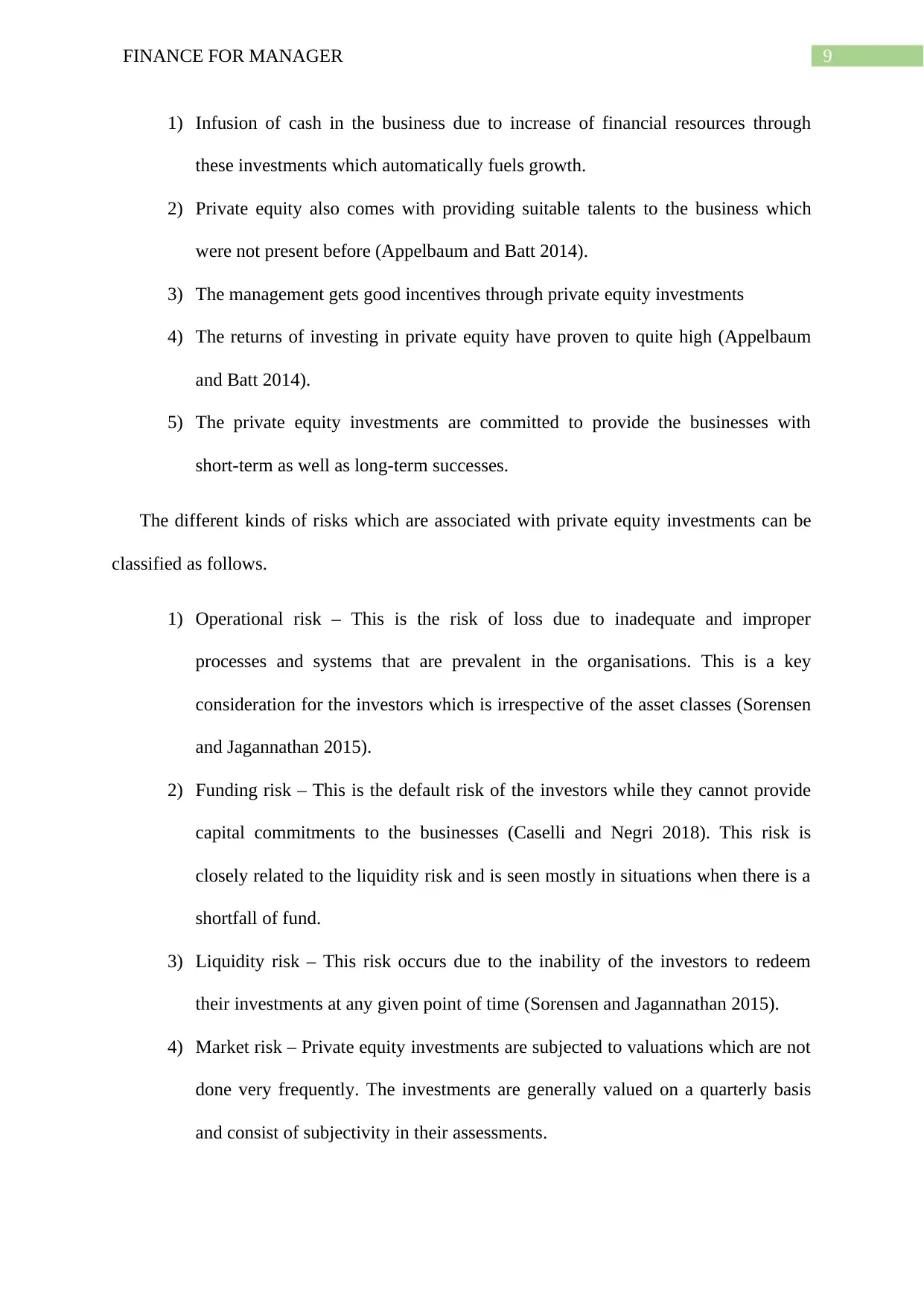
9FINANCE FOR MANAGER
1) Infusion of cash in the business due to increase of financial resources through
these investments which automatically fuels growth.
2) Private equity also comes with providing suitable talents to the business which
were not present before (Appelbaum and Batt 2014).
3) The management gets good incentives through private equity investments
4) The returns of investing in private equity have proven to quite high (Appelbaum
and Batt 2014).
5) The private equity investments are committed to provide the businesses with
short-term as well as long-term successes.
The different kinds of risks which are associated with private equity investments can be
classified as follows.
1) Operational risk – This is the risk of loss due to inadequate and improper
processes and systems that are prevalent in the organisations. This is a key
consideration for the investors which is irrespective of the asset classes (Sorensen
and Jagannathan 2015).
2) Funding risk – This is the default risk of the investors while they cannot provide
capital commitments to the businesses (Caselli and Negri 2018). This risk is
closely related to the liquidity risk and is seen mostly in situations when there is a
shortfall of fund.
3) Liquidity risk – This risk occurs due to the inability of the investors to redeem
their investments at any given point of time (Sorensen and Jagannathan 2015).
4) Market risk – Private equity investments are subjected to valuations which are not
done very frequently. The investments are generally valued on a quarterly basis
and consist of subjectivity in their assessments.
1) Infusion of cash in the business due to increase of financial resources through
these investments which automatically fuels growth.
2) Private equity also comes with providing suitable talents to the business which
were not present before (Appelbaum and Batt 2014).
3) The management gets good incentives through private equity investments
4) The returns of investing in private equity have proven to quite high (Appelbaum
and Batt 2014).
5) The private equity investments are committed to provide the businesses with
short-term as well as long-term successes.
The different kinds of risks which are associated with private equity investments can be
classified as follows.
1) Operational risk – This is the risk of loss due to inadequate and improper
processes and systems that are prevalent in the organisations. This is a key
consideration for the investors which is irrespective of the asset classes (Sorensen
and Jagannathan 2015).
2) Funding risk – This is the default risk of the investors while they cannot provide
capital commitments to the businesses (Caselli and Negri 2018). This risk is
closely related to the liquidity risk and is seen mostly in situations when there is a
shortfall of fund.
3) Liquidity risk – This risk occurs due to the inability of the investors to redeem
their investments at any given point of time (Sorensen and Jagannathan 2015).
4) Market risk – Private equity investments are subjected to valuations which are not
done very frequently. The investments are generally valued on a quarterly basis
and consist of subjectivity in their assessments.
Paraphrase This Document
Need a fresh take? Get an instant paraphrase of this document with our AI Paraphraser
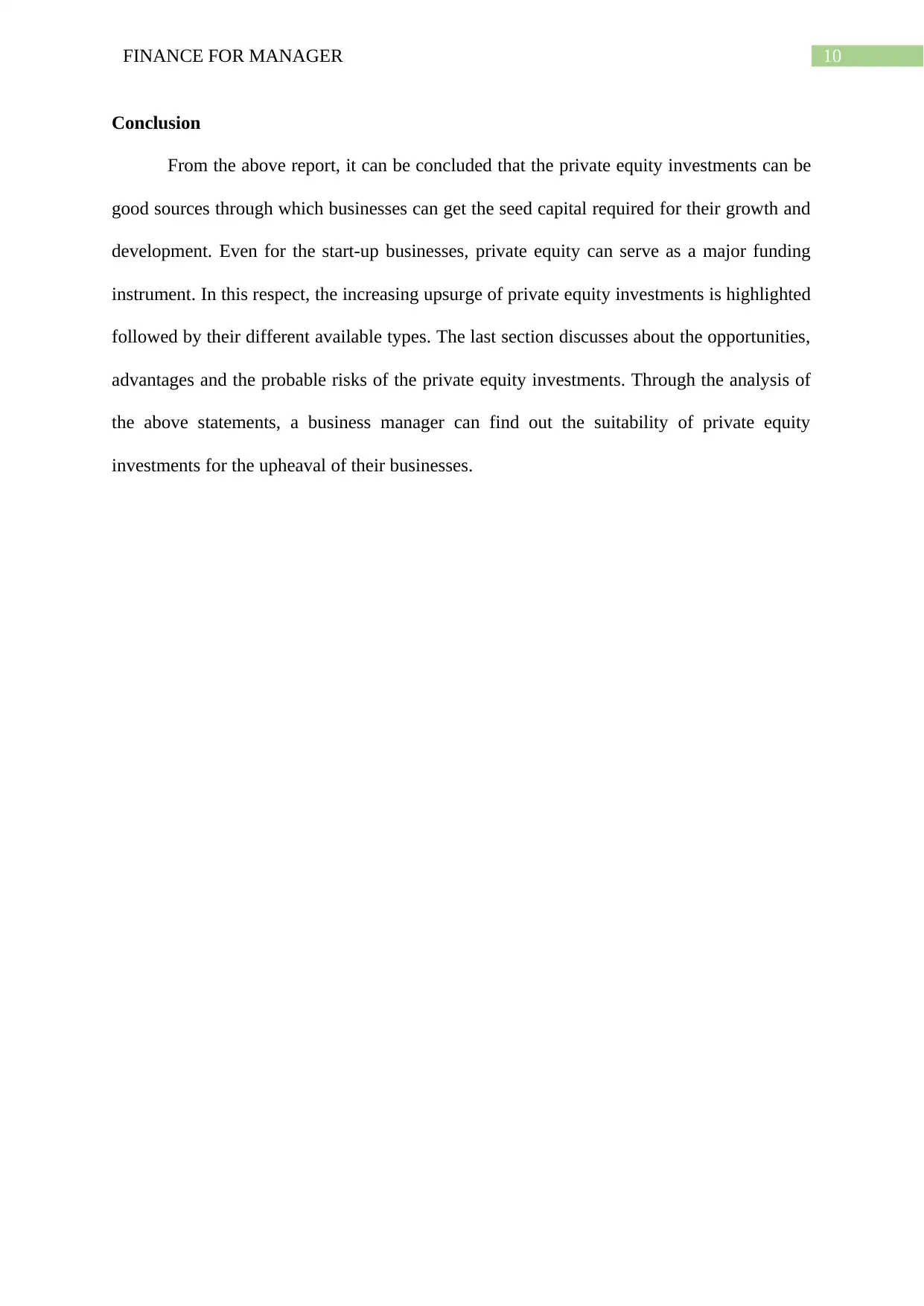
10FINANCE FOR MANAGER
Conclusion
From the above report, it can be concluded that the private equity investments can be
good sources through which businesses can get the seed capital required for their growth and
development. Even for the start-up businesses, private equity can serve as a major funding
instrument. In this respect, the increasing upsurge of private equity investments is highlighted
followed by their different available types. The last section discusses about the opportunities,
advantages and the probable risks of the private equity investments. Through the analysis of
the above statements, a business manager can find out the suitability of private equity
investments for the upheaval of their businesses.
Conclusion
From the above report, it can be concluded that the private equity investments can be
good sources through which businesses can get the seed capital required for their growth and
development. Even for the start-up businesses, private equity can serve as a major funding
instrument. In this respect, the increasing upsurge of private equity investments is highlighted
followed by their different available types. The last section discusses about the opportunities,
advantages and the probable risks of the private equity investments. Through the analysis of
the above statements, a business manager can find out the suitability of private equity
investments for the upheaval of their businesses.
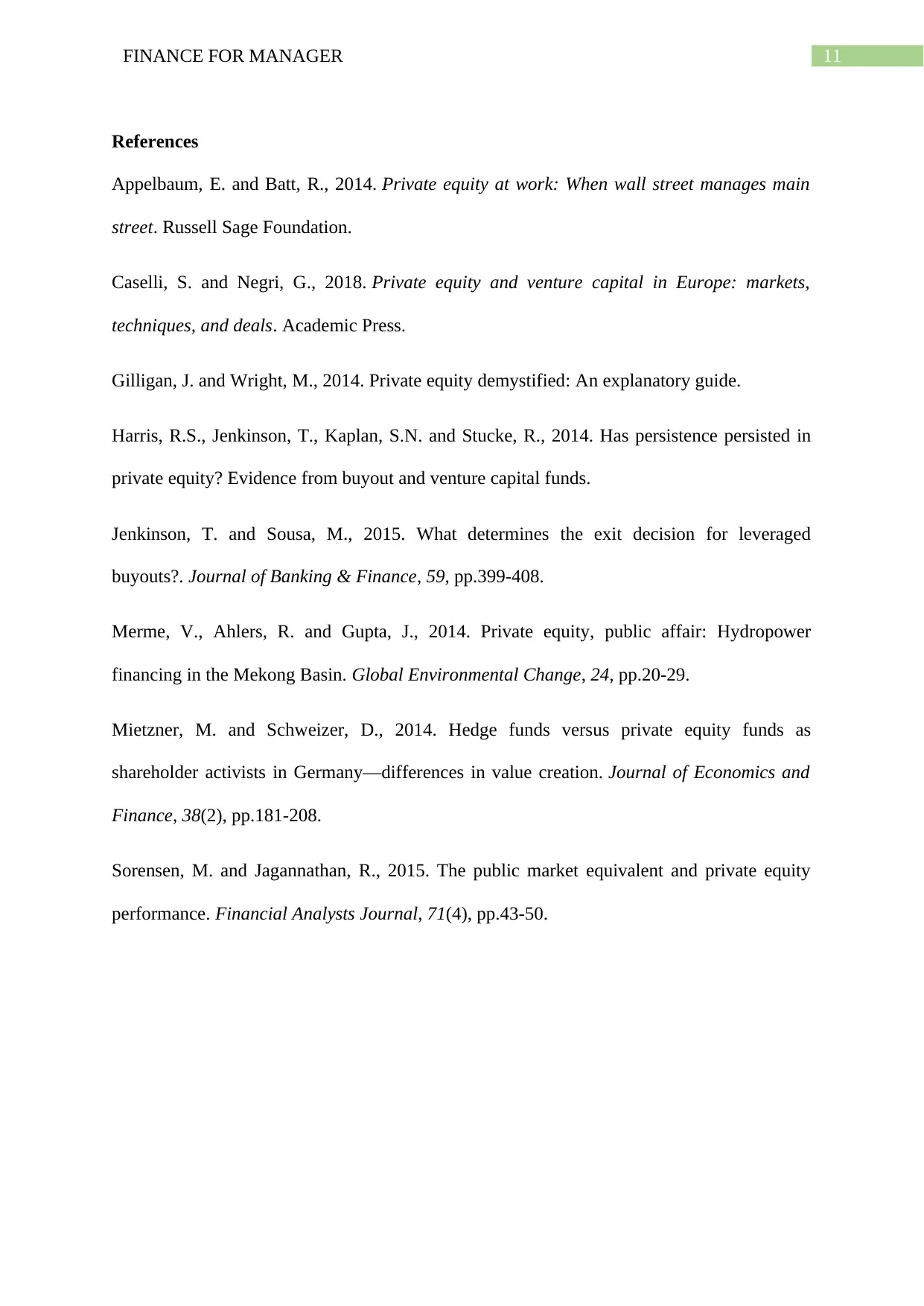
11FINANCE FOR MANAGER
References
Appelbaum, E. and Batt, R., 2014. Private equity at work: When wall street manages main
street. Russell Sage Foundation.
Caselli, S. and Negri, G., 2018. Private equity and venture capital in Europe: markets,
techniques, and deals. Academic Press.
Gilligan, J. and Wright, M., 2014. Private equity demystified: An explanatory guide.
Harris, R.S., Jenkinson, T., Kaplan, S.N. and Stucke, R., 2014. Has persistence persisted in
private equity? Evidence from buyout and venture capital funds.
Jenkinson, T. and Sousa, M., 2015. What determines the exit decision for leveraged
buyouts?. Journal of Banking & Finance, 59, pp.399-408.
Merme, V., Ahlers, R. and Gupta, J., 2014. Private equity, public affair: Hydropower
financing in the Mekong Basin. Global Environmental Change, 24, pp.20-29.
Mietzner, M. and Schweizer, D., 2014. Hedge funds versus private equity funds as
shareholder activists in Germany—differences in value creation. Journal of Economics and
Finance, 38(2), pp.181-208.
Sorensen, M. and Jagannathan, R., 2015. The public market equivalent and private equity
performance. Financial Analysts Journal, 71(4), pp.43-50.
References
Appelbaum, E. and Batt, R., 2014. Private equity at work: When wall street manages main
street. Russell Sage Foundation.
Caselli, S. and Negri, G., 2018. Private equity and venture capital in Europe: markets,
techniques, and deals. Academic Press.
Gilligan, J. and Wright, M., 2014. Private equity demystified: An explanatory guide.
Harris, R.S., Jenkinson, T., Kaplan, S.N. and Stucke, R., 2014. Has persistence persisted in
private equity? Evidence from buyout and venture capital funds.
Jenkinson, T. and Sousa, M., 2015. What determines the exit decision for leveraged
buyouts?. Journal of Banking & Finance, 59, pp.399-408.
Merme, V., Ahlers, R. and Gupta, J., 2014. Private equity, public affair: Hydropower
financing in the Mekong Basin. Global Environmental Change, 24, pp.20-29.
Mietzner, M. and Schweizer, D., 2014. Hedge funds versus private equity funds as
shareholder activists in Germany—differences in value creation. Journal of Economics and
Finance, 38(2), pp.181-208.
Sorensen, M. and Jagannathan, R., 2015. The public market equivalent and private equity
performance. Financial Analysts Journal, 71(4), pp.43-50.
⊘ This is a preview!⊘
Do you want full access?
Subscribe today to unlock all pages.

Trusted by 1+ million students worldwide
1 out of 12
Related Documents
Your All-in-One AI-Powered Toolkit for Academic Success.
+13062052269
info@desklib.com
Available 24*7 on WhatsApp / Email
![[object Object]](/_next/static/media/star-bottom.7253800d.svg)
Unlock your academic potential
Copyright © 2020–2025 A2Z Services. All Rights Reserved. Developed and managed by ZUCOL.





